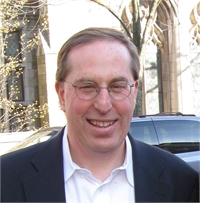Abstract: A laser is an optical device that transforms incoherent input energy (the pump), into coherent outgoing radiation in a specific set of modes of the electromagnetic field, with distinct frequencies. There is a threshold pump energy for the first lasing mode, and above that energy the laser is a non-linear device, and non-linear interactions strongly affect the emission properties of the laser. Surprisingly, the electromagnetic theory of non-linear steady-state multimode lasing remained rather rudimentary until recently. Motivated by the complex laser cavities being developed in modern micro and nano-photonics, we have developed a new formalism, Steady-state Ab initio Laser Theory (SALT), which calculates directly all the steady-state lasing properties without integration of the semiclassical lasing equations in time; hence it is orders of magnitude more efficient, and provides additional analytic insight. The method is based on non-hermitian states of the electromagnetic field, which provide a quantitative and tractable description of arbitrarily complicated laser systems, including extremely open and non-linear examples, such as random lasers. SALT also provides the basis for a quantitative theory of quantum fluctuation properties of the laser, leading to a novel generalization of the Schawlow-Townes formula.
Our reformulation of laser theory emphasizes that a laser cavity is a certain kind of scattering system, with a non-unitary amplifying scattering matrix due to the presence of gain. This approach suggested the possibility of constructing a time-reversed or "anti-laser", which we term a coherent perfect absorber (CPA); a linear device in which the gain medium of the laser is replaced with a loss medium such that the cavity will perfectly absorb the incoming (time-reversed) modes of the corresponding laser at threshold. Recently we have experimentally demonstrated such a device in a simple silicon cavity, which acts as an absorptive interferometer, in which narrow-band absorption can be both increased to ~ 99% and reduced to ~30%. The time-reverse of random lasing can in principle permit light to penetrate strong-scattering media that are opaque under typical illumination conditions. Time-reversed optical parametric oscillation can also be studied in the same framework, leading to new insights and possible applications.
Biography: A. Douglas Stone is Carl A. Morse Professor and Chair of Applied Physics, and Professor of Physics at Yale University. He joined the Yale faculty in 1986 after obtaining his PhD in theoretical condensed matter physics from MIT in 1983, under the supervision of John Joannopoulos, and a postdoctoral fellowship at the IBM T. J. Watson Research Center. His general area of interest is complex and disordered wave phenomena in space, including the effects of interactions and non-linearity. The first part of his research career was focused on mesoscopic electron physics, where he and Patrick Lee pioneered the concept of Universal Conductance Fluctuations, due to electron interference in nanostructures. For the past fifteen years most of his research has focused on novel laser systems and fundamental laser theory. He introduced the concept of microlasers with chaotic ray dynamics and the phase space method to predict their output, and his group has pioneered Steady-state Ab initio Laser Theory (SALT), a method to solve the multimode laser equations above threshold in cavities of arbitrary complexity, including random lasers. Most recently, working with Hui Cao, he has developed the concept of time-reversed lasing ("the anti-laser") and demonstrated a non-trivial realization thereof. He is a Fellow of the American Physical Society and the Optical Society of America, and is the recipient of a Rhodes Scholarship, a Sloan Faculty Fellowship, and the MacMillan Award of the University of Illinois. He has a BA in Social Studies from Harvard and an MA in Physics and Philosophy from Balliol College, Oxford. His popular book on the history of science, "Einstein and the Quantum: The Quest of the Valiant Swabian" is in press at Princeton University Press.


